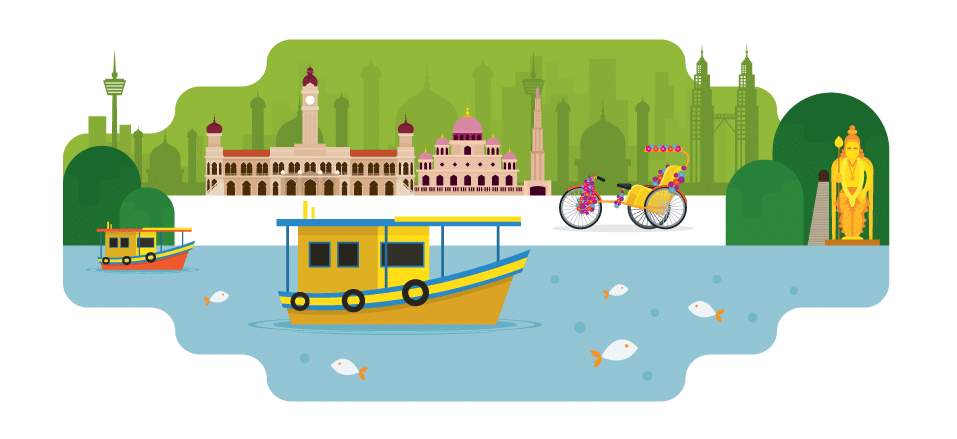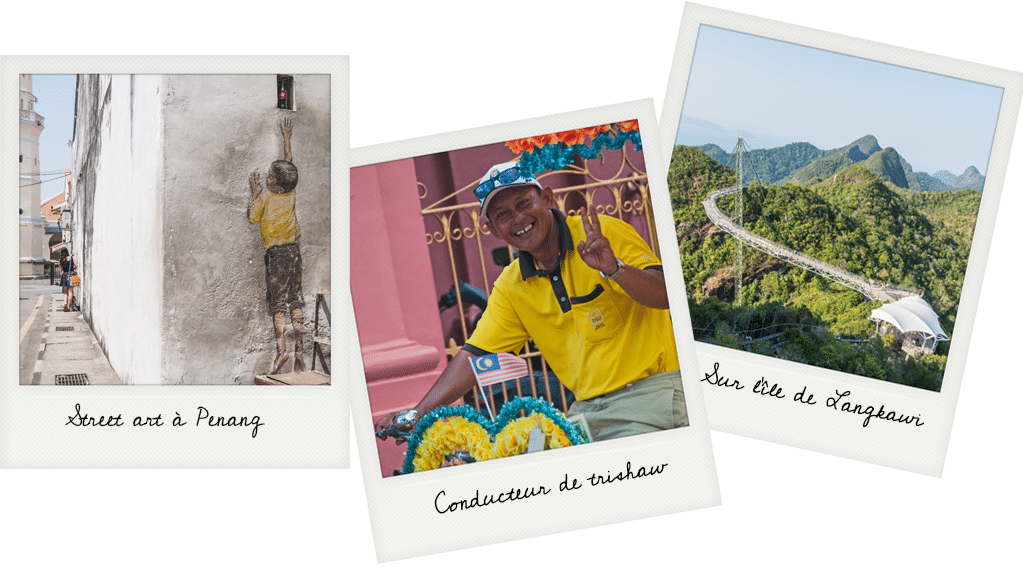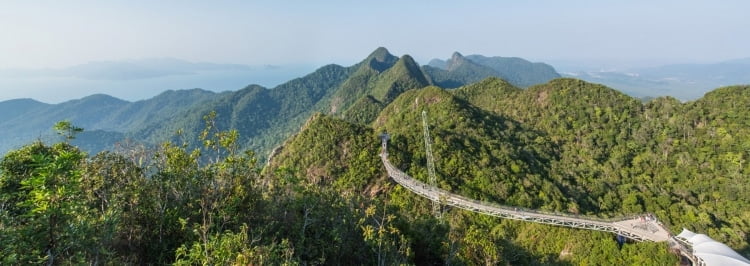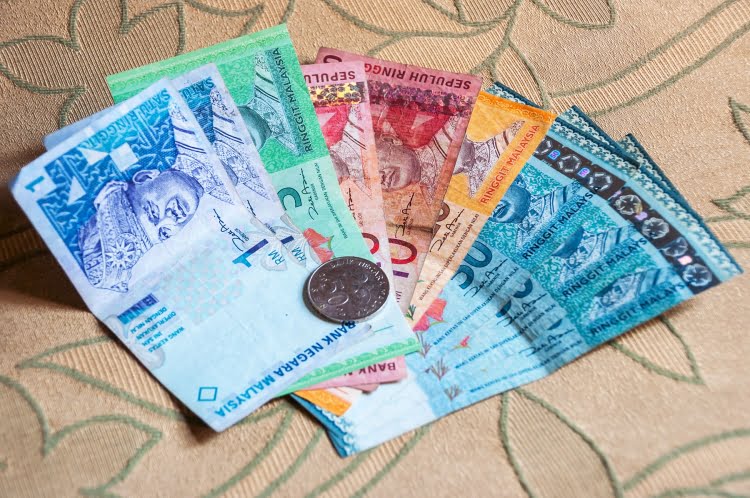Why visit Malaysia?
Malaysia is often presented as a amazing mix of cultureswith a very different atmosphere from its Southeast Asian counterparts. Many see it as a "quieter alternative" to Thailand, when in reality, the country hosts nearly 25 million visitors every year.
If it seems less touristy, it's mainly because 95% of travelers come from Asia Western visitors are much less visible there. In comparison, the British – despite being the largest European nationality – account for barely 400,000 arrivals per year.
Culturally, Malaysia is the result of a long mix of influences: Malay, Chinese, Indian… but also colonial. Portuguese, Dutch and British have left their mark on cities like Malacca and George Town, which are still very visible in architecture and gastronomy.
The country is easy to browse Convenient domestic flights, frequent buses, decent infrastructure, and accommodation options are readily available. Traveling in Malaysia remains simple and smooth, even for a first-time visit to the region.
The peninsula, like Borneo, offers astonishing diversity: jungle-covered hillsCooler mountains, mangroves, beaches, islands, ultramodern cities or colonial quarters… Malaysia condenses a good part of Southeast Asia into a single country.
The areas covered by ancient forests These areas still harbor rare wildlife – including the last orangutans of Malaysian Borneo – even though they are shrinking under agricultural pressure. For lovers of nature, trekking, national parks, and biodiversity, it's a fascinating territory.
Island lovers will not be disappointed: Malaysia has many diving spots renowned, superb beaches and islands where you can still find tranquility, far from the crowds.

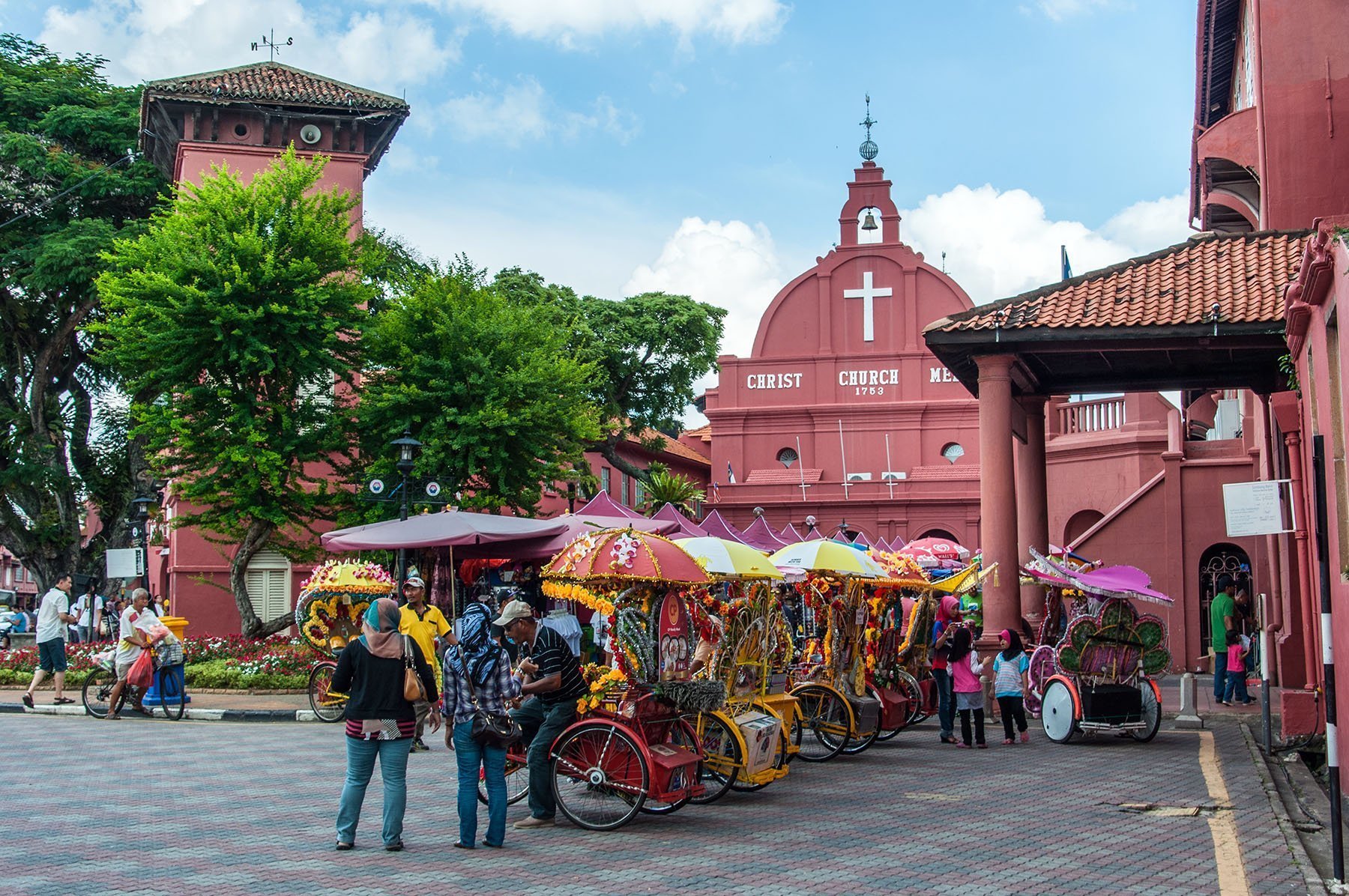
Administratively, Malaysia forms a federation of states This can sometimes be confusing for a visitor, but it explains the variety of local identities. Sabah and Sarawak, on Borneo, only joined the federation in 1963, while the Sultanate of Brunei chose to remain independent.
Another notable feature: Malaysia is a elective constitutional monarchyThe king (Yang di-Pertuan Agong) is not hereditary: he is chosen for 5 years from among the sovereigns of the nine monarchical states of the peninsula.
Ultimately, this mix of multiculturalism, dense nature, modernity, colonial history and regional diversity creates a country rich, contrasting and very easy to travelwhich deserves far more than a simple visit.
In short: a destination easy, varied et pleasant to travelBlending nature, culture and modernity. Ideal if you are looking for a Southeast Asian country that is both exotic, accessible, and less frequented by Western travelers.
- unique cultural mix : Malay, Chinese, Indian influences.
- Dense Nature Ancient jungles, national parks, orangutans.
- Stunning islands : beaches, snorkeling and diving are top-notch.
- Easy travel : good transport, accommodation everywhere.
- Varied cuisine and accessible.
- Reasonable cost for the region.
- A varied cuisine, certainly, but not always exceptional depending on the region.
- On the same topic, coffee often has mixed reviews. (depending on where you go, it varies… and it can be frustrating if you like good coffee).
- Perhaps it lacks the more "fun" side that Thailand can have.
Do I need a visa to enter Malaysia?
No. French citizens do not require no visa to enter Malaysia for tourism purposes. Upon arrival, you simply obtain a 90-day stamp (3 months) on your passport.
This visa exemption also applies to all countries of the European Union, as well as the Swiss et CanadiensOther nationalities frequently present on this site also benefit from it, notably the Algerians, Tunisians et Moroccan.
However, some nationalities only receive one 30-day stay (mainly in Africa and Asia). To see the full list: official website of Malaysian immigration (in English).
Special feature of Sabah/Sarawak
Upon entering the (Sabah or the family Sarawak (Malaysian Borneo), you receive a separate buffer federated states. The duration, however, remains the same: 90 days also for the French.
Extension of stay?
Extensions beyond 90 days are not not automatic and rarely granted (except in specific cases: family, medical reasons, or residency application). For the majority of travelers, a visa run A simple procedure is not always sufficient to reset the stay: it all depends on the immigration officer and the frequency of entry into the country.
As part of a typical trip, the 90 days The options offered are more than sufficient to explore Peninsular Malaysia, Sabah and Sarawak.
Malaysia has a equatorial climate : constant heat, high humidity and possible showers at any time of the year. Two monsoons alternate and influence the coasts differently is et west.
Temperatures are hovering around 30-32°C all year round. In high-altitude areas, such as the Cameron Highlands (approx. 1,400 m), the air is noticeably milder with days around 20-23°C.
Winter monsoon (November → March)
- Also called northeast monsoon.
- This is the most rainy on East Coast of the peninsula (Perhentian, Redang, Tioman).
- December is often the wettest month.
Summer monsoon (late May → September)
- called southwest monsoon.
- It affects the Western coast (Penang, Langkawi, Pangkor), but in a more moderate way.
- Classic alternation of sun and tropical showers.


Best time to visit Malaysia
The period offering the best compromise In Malaysia, it is generally between June and Septemberthanks to a less violent summer monsoon and more frequent sunshine.
In short
- Overall period to avoid : November → January.
- Months often considered ideal: february, June et July.
That said, the country is very spread out and conditions vary greatly depending on the region:
West Coast (Langkawi, Penang, Pangkor)
- Less affected by the rains.
- Good period, often extended January to August.
- Climate similar to southern Thailand (Ko Lipe, Satun, Trang).
East coast (Perhentian, Redang, Tioman)
- Peak rainy season November → January.
- The islands may be closed or difficult to access during this period.
- Best time: March → September.
Borneo (Sabah & Sarawak)
- High rainfall throughout the year, but with strong local variations.
- No real dry season, but more stable weather windows depending on the area.
Weather — Malaysian Peninsula (Kuala Lumpur, west & east coast)
| Month | Minimum temperature | Maximum temperature | Rain | Features |
|---|---|---|---|---|
| Jan. | 23 ° C | 30 ° C | 220mm | Monsoon season is over on the east coast, weather on the west coast is often fine. |
| Feb. | 23 ° C | 31 ° C | 180mm | A good compromise almost everywhere, showers but often short. |
| Mars | 24 ° C | 32 ° C | 210mm | Humid heat, conditions still stable in most regions. |
| Apr. | 24 ° C | 32 ° C | 230mm | Heavy weather month, more frequent thunderstorms in the afternoon. |
| Mai | 24 ° C | 32 ° C | 240mm | Intense heat, regular showers, still very doable. |
| June | 23 ° C | 31 ° C | 180mm | One of the most pleasant times of year, especially on the west coast. |
| Jul. | 23 ° C | 31 ° C | 190mm | Good month for the whole peninsula, bearable heat. |
| August | 23 ° C | 31 ° C | 200mm | Good window for the west coast and the islands (Langkawi, Penang). |
| Sept. | 23 ° C | 31 ° C | 220mm | Return of more frequent showers, heavy atmosphere. |
| Oct. | 23 ° C | 31 ° C | 260mm | Very wet month, frequent thunderstorms, sometimes rough seas. |
| Nov. | 23 ° C | 30 ° C | 350mm | Northeast monsoon: heavy rain on the east coast, more unstable conditions elsewhere. |
| Dec. | 23 ° C | 30 ° C | 280mm | Monsoon still active on the east coast, frequent showers on the rest of the peninsula. |
Weather — Malaysian Borneo (Sabah & Sarawak)
| Month | Minimum temperature | Maximum temperature | Rain | Features |
|---|---|---|---|---|
| Jan. | 24 ° C | 31 ° C | 680mm | Very rainy on the Sarawak (Kuching) side, more acceptable towards Sabah but very humid atmosphere. |
| Feb. | 24 ° C | 31 ° C | 480mm | Still a lot of rain in the southwest, more stable conditions towards Kota Kinabalu. |
| Mars | 24 ° C | 32 ° C | 330mm | Heavy heat, frequent showers but some beautiful windows. |
| Apr. | 25 ° C | 32 ° C | 290mm | Often a more stable period, a good compromise for Sarawak and Sabah. |
| Mai | 25 ° C | 32 ° C | 260mm | Good period overall, showers mainly at the end of the day. |
| June | 24 ° C | 32 ° C | 210mm | One of the driest periods for Kuching, a good month for the jungle and parks. |
| Jul. | 24 ° C | 31 ° C | 200mm | Conditions are often favorable for the coast and the islands (Sabah). |
| August | 24 ° C | 31 ° C | 200mm | Good time for outdoor activities, still very humid but a little less rainy. |
| Sept. | 24 ° C | 31 ° C | 260mm | Return of heavier rainfall, often overcast skies. |
| Oct. | 24 ° C | 31 ° C | 330mm | Very humid month, heavy rains frequent (especially around Kota Kinabalu and Kuching). |
| Nov. | 24 ° C | 31 ° C | 430mm | Very wet period, prolonged episodes of rain, less pleasant for travel. |
| Dec. | 24 ° C | 31 ° C | 480mm | A very wet end to the year, with heavy rains especially on the Sarawak side. |
Here are the main attractions in Malaysia, grouped into four main areas.
1) West Coast & Kuala Lumpur
Malaysia is often discovered via the west coast. It's easy to hop from island to island, explore a large historic city, a modern capital, and enjoy the cooler hills. From north to south, you'll find... Langkawi Island, practically bordering Thailand, then further down, Penang Island, where you can discover the colorful streets of George Town through its street art.
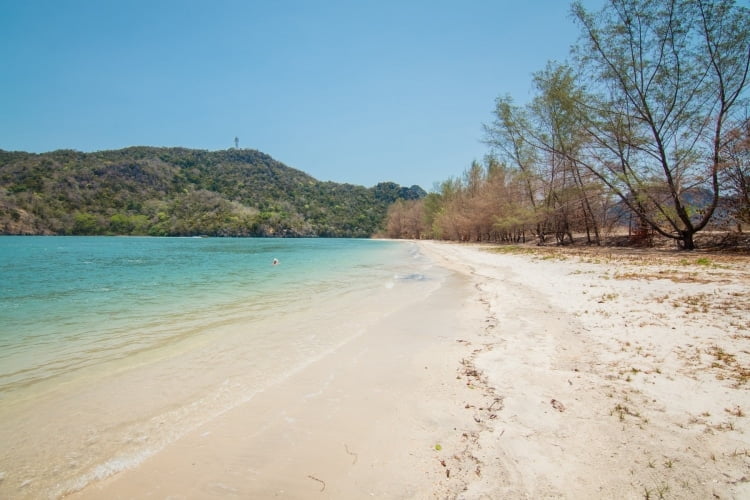
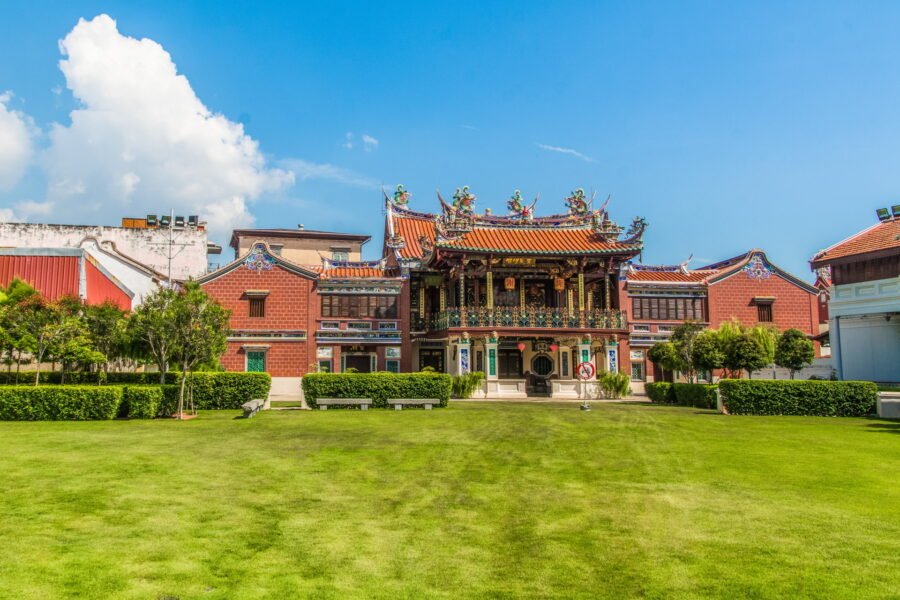
Further south, you'll find another island, less known to foreign tourists. Pangkorwhich boasts several beaches perfect for a relaxing weekend getaway. Heading back inland, you can stroll through the alleyways of Ipoh, an old mining town surrounded by karst cliffs. Finally, in the nearby mountains, the Cameron Highlands and their tea plantations They await you for a bit of coolness at altitude.
Finally, it is in this region that we find the historical capital of Kuala Lumpur, a clever mix of culture and the old Portuguese trading post in Malacca.

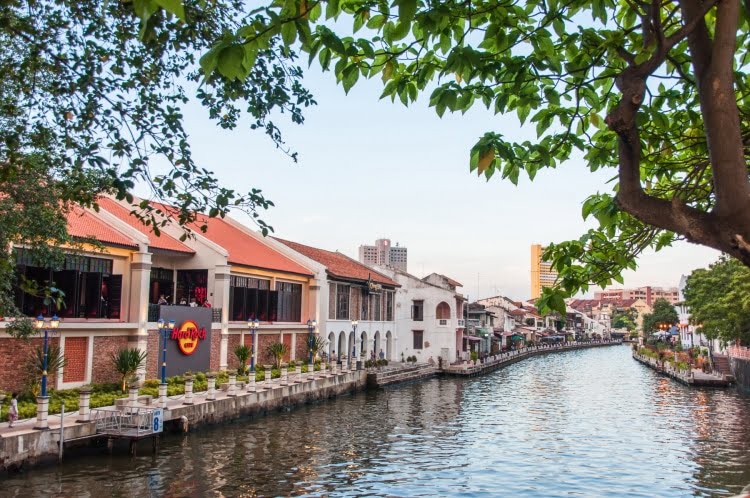
Between beaches, street art, Chinese temples, tea plantations and colonial districts, this part of Malaysia already allows you to build a very complete trip, without ever leaving the peninsula.
Langkawi Island
Large island in the far northwest of the peninsula, Langkawi It remains surprisingly peaceful for its size. People come here as much to relax as to enjoy the views and nature outings, with the added bonus of being able to connect with southern Thailand (Ko Lipe, Satun…).
Things to see / things to do
- Langkawi Sky Bridge – suspension bridge accessible by cable car, panoramic view of the west coast.
- Seven Wells Waterfalls – natural pools in the middle of the vegetation.
- Kilim Geoforest Park – boat trip in the mangroves, limestone cliffs, wildlife.
- Cenang Beach – large lively beach, restaurants and seaside activities.
- Tanjung Rhu & North Island – quieter beaches, more upscale atmosphere.
Recommended time: 2 to 4 days. depending on whether you're making it a simple stopover or a real seaside break.
Penang & George Town
The island of Penang, and especially the city of George Town, is a Malaysian classic. It features a mix of street art, temples, colonial houses, small eateries and the atmosphere of a modernized old Asian town.
Things to see in town
- Street art of George Town – murals, sculptures “Making George Town”, ideal walking tour.
- Khoo Kongsi – a richly decorated Chinese clan temple.
- Blue Mansion – famous indigo house, guided tours available.
- Historic districts – old shophouses, temples and mosques side by side.
Around George Town
- Kek Lok Si Temple – large Buddhist complex, one of the best known in the country.
- Penang Hill – funicular ride up, view of the island and the coast.
- Beaches north of Penang – to take a breather, even if it's not the most beautiful coastline in the country.
Recommended time: 2 to 3 days. to combine George Town, Kek Lok Si and Penang Hill.
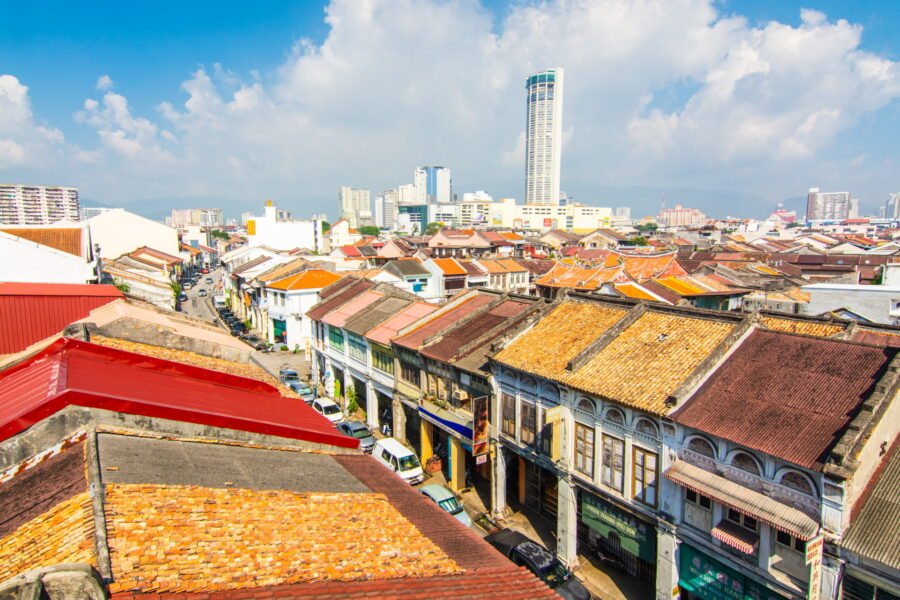

Ipoh & surrounding area
Often seen as a mere step, ipoh However, it can be quite pleasant if you have some time. Colonial center, discreet street art, cafes/restaurants and especially cave-temples at the foot of the limestone cliffs.
In the city
- Old City – colonial facades, quiet streets, cafes.
- Murals – a few frescoes scattered around the center.
Around Ipoh
- Cave-temples – temples built in karst cliffs (Sam Poh Tong, Perak Tong, etc.).
- Kellie Castle – unfinished construction by a wealthy Scottish owner, a slightly timeless atmosphere.
Recommended time: 1 to 2 days., often combined with the road to the Cameron Highlands.
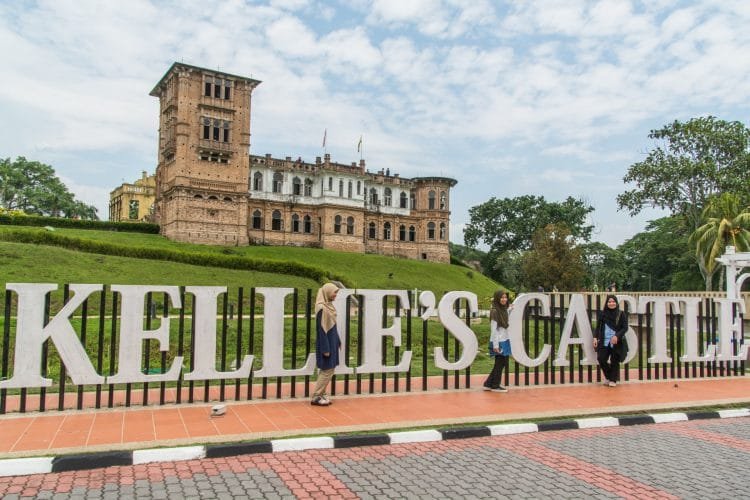

Cameron Highlands
On Cameron HighlandsThe areas around Tanah Rata offer a cooler respite between tea plantations, hills and mossy forests.
Things to see / things to do
- Tea plantations – views of the impeccably designed hills, tours and tastings.
- Hiking – trails around the “moss forest” and surrounding peaks.
- Local markets – fruits, vegetables and local produce.
Recommended time: 2 days to enjoy the plantations and one or two walks.

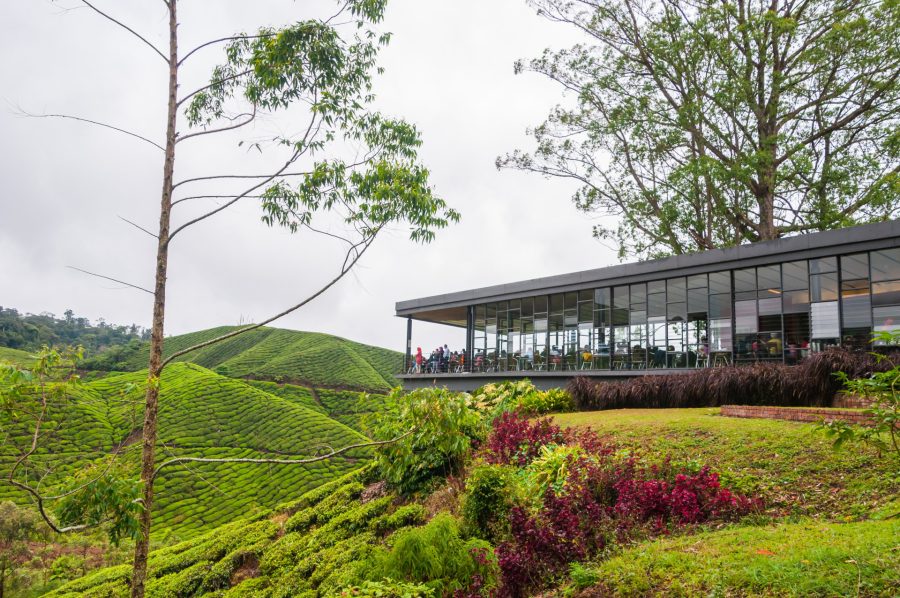
Pangkor Island
A small island off the west coast, Pangkor It serves more as a simple and tranquil seaside bonus.
Things to see / things to do
- Pangkor Beaches – some beautiful coves to relax in peace.
- Fishing villages – a more local atmosphere than on the better-known islands.
Recommended time: 1 to 2 days. if you are looking for an unpretentious seaside break.
Kuala Lumpur
Modern capital of Malaysia, Kuala Lumpur a mix of skyscrapers, large shopping centers, old neighborhoods and some traces of its colonial heritage.
Things to see in town
- Petronas Towers & KLCC Park – symbol of the city, green spaces at the foot of the towers.
- Place de l'Indépendance – colonial facades including the building Sultan Abdul Samad.
- Bukit Bintang – mall and shopping district.
- Chinatown (Petaling Street) – market, stalls, more popular atmosphere.
- Central market – crafts and souvenirs under one roof.
Around Kuala Lumpur
- Batu Caves – large Hindu shrine in the rock, easily accessible by transport.
Recommended time: 2 to 3 days. for a good overview of the city and a trip to the Batu Caves.
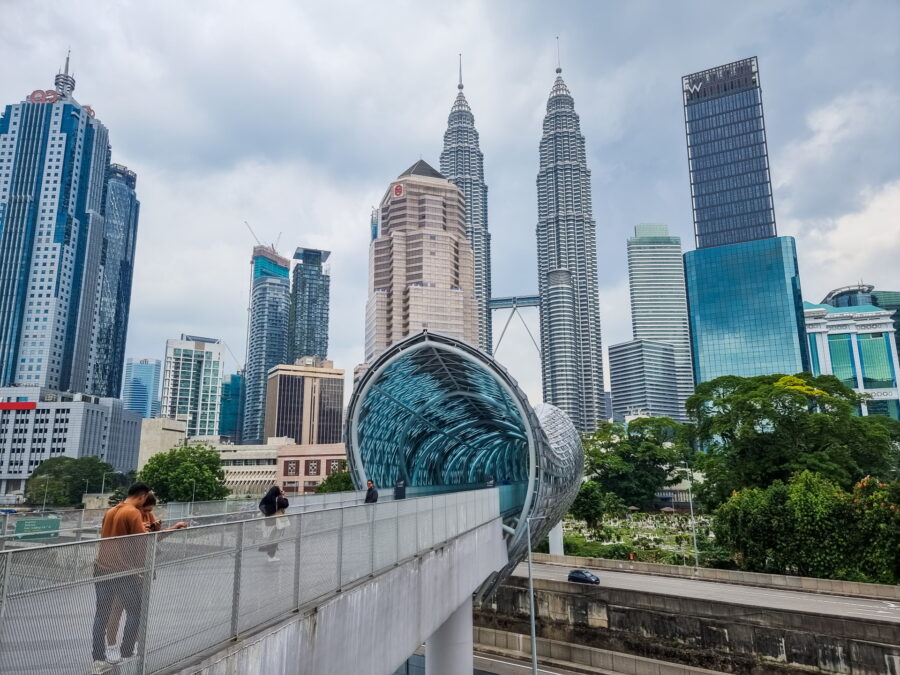

Malacca (Melaka)
Former major port on the strait, Melaka (Melaka) retains a historic center heavily marked by Portuguese, Dutch and British influences.
Things to see / things to do
- Red place – iconic red buildings (church, clock tower).
- Fort A Famosa – remains of the Portuguese fort.
- St. Paul's Church – on the hill, beautiful view of the city.
- Jonker Street – heart of Chinatown, lively night market.
- Cheng Hoon Teng Temple – a richly decorated 17th-century Chinese temple.
- Kampung Kling Mosque – architecture blending local and Javanese styles.
- Walk along the river – on foot or by boat, to see frescoes and old houses.
Recommended time: 1 to 2 days., either as a stopover between Kuala Lumpur and Singapore or as a loop on the west coast.


2) East Coast & Islands
The east coast of the peninsula presents a wilder side: vast stretches of forest, tranquil villages, and some of Malaysia's most beautiful islands for snorkeling and diving. It's also home to several major national parks, both in the north and inland.
North, Royal Belum State Park and National Park protect an ancient rainforest, with artificial lakes, rivers, trails and some Orang Asli villagesFurther south, the Terengganu region serves as a starting point towards the perhentian islandsRedang, Kapas or Tenggol, all facing the sea and the seabed.


Going down further, we reach Tioman Island and some more secluded islands off the coast of Johor, for those who want to get away from the more classic routes.
Between jungle, marine parks and picture-perfect beaches, the east coast is ideal if you are looking for a more natural Malaysia, with stages often centered on a few days in the same place.
Royal Belum State Park
In the northeast of the peninsula, on the Thai border, the Royal Belum State Park protects one of the oldest rainforests in the world.
Things to see / things to do
- Boat trips – navigation on the artificial lake, landscapes of hills and dense forest.
- Orang Asli Villages – indigenous populations such as the Semangs or Senois.
- Wildlife and plant observation – birds, insects, tropical trees, possibility (rare) of seeing the flower Rafflesia.
Recommended time: 2 to 3 days., often in the form of an organized stay with accommodation on site.
Taman Negara & Lake Kenyir
Le National Park It is the most famous national park on the peninsula, easily accessible from Kuala Lumpur. People come here for the atmosphere of the primary forest, the rivers and the famous canopy walk.
Things to see / things to do
- Canopy Walk – suspended walkways in the canopy.
- Forest walks – short trails or longer hikes with a guide.
- Canoe trips – Upstream along the river, small waterfalls.
Lake Kenyir
- Cruises & Floating Holidays – very calm atmosphere, nature by the water.
Recommended time: 2 to 3 days. for Taman Negara alone, even more so if you add Lake Kenyir.
Perhentian Islands
On Perhentian Islands (Perhentian Besar & Perhentian Kecil) are often the big favorite on the east coast: turquoise water, white sand beaches and a still fairly simple atmosphere.
Things to see / things to do
- Snorkeling & diving – turtles, tropical fish, accessible reefs.
- Perhentian Besar Beaches – a little quieter, some comfortable accommodations.
- Perhentian Kecil – more choice of guesthouses and a small beach lifestyle.
The Perhentian Islands are part of a marine park: there is a conservation tax upon arrival, and most accommodations close during the monsoon season (roughly from October to March).
Recommended time: 3 to 4 days. to really enjoy it.
Redang, Kapas & Tenggol
Further south, the coast of Terengganu provides access to several islands that are very oriented towards the sea and snorkeling.
redang
- Redang Beaches – white sand, crystal clear water, resort atmosphere.
- Chagar Hutang Turtle Sanctuary – turtle sanctuary (access restricted).
Kapas & Tenggol
- Cotton Island – small island close to the coast, ideal for a few days of peace and quiet.
- Pulau Tenggol – renowned for diving, but with more limited visitor numbers.
Recommended time: 2 to 4 days. depending on the island chosen and your diving preferences.
Tioman Island & Johor Islands
Further south, off the coast of Mersing, Tioman and the islands of Johor offer other beach options, a little less so in classic tours.
Tioman
- Tekek & Salang Villages – main bases for accommodation and organizing outings.
- Marine Park – snorkeling and diving around the island.
- Duty-free status – island considered a tax-free zone.
Other islands
- Sibu & Tinggi – islands closer to the coast, relaxing atmosphere.
- Aur & Dayang – further away, renowned for diving.
Recommended time: 2 to 4 days. depending on the amount of travel effort you are willing to make.
3) Sarawak (Malaysian Borneo)
On the island of Borneo, Sarawak occupies a vast portion of the northwest coast. In practice, the focus is mainly on two main axes: the Kuching region to the south, then the corridor Sibu – Miri further north, which provides access to several national parks and to famous Gunung Mulu caves.
Around Kuching, the landscape alternates between tranquil seafronts, coastal parks like Bako or Kubah, and conservation centers, particularly for the orangutans at SemenggohIt's also a good base for discovering some affordable longhouses, like those in Annah Rais. Further inland, Lake Batang Ai allows you to go further into the jungle and stay in Iban villages.

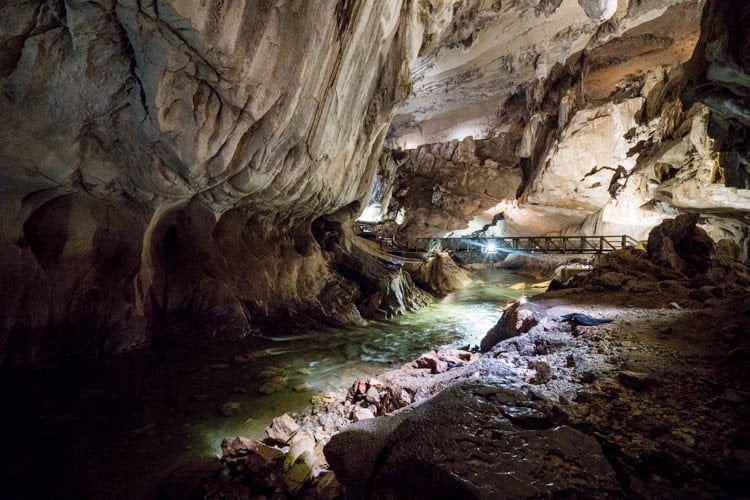
Heading north, Sibu serves as a river stop before reaching Bintulu, Niah Park and finally Miri. From there, one can access the Gunung Mulu National Park, registered in Unesco World Heritageknown for its spectacular caves and limestone pinnacles, with treks possible for those who want to take the adventure a little further.
Kuching, Bako & Semenggoh
Capital of Sarawak, Kuching is a very convenient base for exploring coastal national parks and some conservation centers.
In Kuching
- River front – walk along the river, view of the city.
- Fort Margherita – old fort overlooking the river.

Parks and centers nearby
- Bako National Park – coastal peninsula with varied landscapes, trails, proboscis monkeys, beaches (swimming often discouraged because of crocodiles).
- Kubah National Park – tropical forest, waterfall near Mount Serapi.
- Semenggoh Wildlife Center – Orangutan observation/rehabilitation center.
Longhouses nearby
- Annah Rais – fairly accessible longhouse, homestay option available.
Recommended time: 3 to 4 days. to combine Kuching, Bako and a trip to Semenggoh or Annah Rais.
Batang Ai & Sibu region
Further inland, the sector of Lake Batang Ai allows combining jungle, lake and Iban villages.
Things to see / things to do
- Batang Ai National Park – jungle, boat trips, bird watching.
- Longhouses IBAN – stays in long traditional houses around the lake.
The region is often combined with a visit to sibu, a river city that serves as a stopover between Kuching and northern Sarawak.
Recommended time: 2 to 3 days. to include travel and one night in a longhouse.
Niah National Park
Between Sibu and Miri, the Niah National Park is best known for its caves.
Things to see / things to do
- Great Cave – large cavity famous for its very ancient human remains.
- Painted Cave – rock paintings, accessible via a path behind the main cave.
- Forest trails – walking on footbridges and shaded paths.
Recommended time: 1 day, often as a stopover on the way up to Miri.
Miri & Gunung Mulu National Park
From Miri, we access the Gunung Mulu National Park, a UNESCO World Heritage Site, known for its spectacular caves and pinnacles.
Main caves
- Clearwater Cave – one of the longest caves in Southeast Asia, with an underground river.
- Deer Cave & Langs Cave – impressive caverns, spectacle of bats emerging in the evening.
- Cave of the Winds – stalagmites, stalactites and a constant flow of fresh air.
Hiking
- Headhunters Trail – trek combining jungle and villages, reminiscent of the “headhunters”.
- Pinnacles Trail – demanding trek to the limestone pinnacles of Mount Api (for experienced walkers only).
Recommended time: 3 days minimum to enjoy the main caves and a trek.
4) Sabah (Malaysian Borneo)
At the northeastern tip of Borneo, Sabah combines a little bit of everything that makes the island so appealing: a summit at over 4,000 m, islands with crystal-clear waters, rivers lined with jungle and several conservation areas where wildlife is more easily spotted.
Around Kota Kinabalu, we can also go to the islands of Tunku Abdul Rahman Marine Park than aiming to climb Mount Kinabalu, the highest point in Malaysia.


Further east, towards Sandakan and Sepilok, there are several centers dedicated to orangutans, sun bears and a beautiful network of walkways in the canopy, before descending along the Kinabatangan River in search of proboscis monkeys, crocodiles, pygmy elephants and tropical birds.
Continuing southeast, Lahad Datu serves as the gateway to the Danum Valley and the Tabin Reserve, two areas of primary forest that are very popular with nature lovers. Finally, around Sempornawe switch into a world of lagoons, islands and floating villages, with renowned spots like Mabul, Bohey Dulang or Sipadan for diving.
Kota Kinabalu, Mount Kinabalu & Tunku Abdul Rahman Park
Kota Kinabalu (KK for those in the know) is the gateway to Sabah, the starting point for the mountains and some nearby islands.
Mount Kinabalu
- Ascent of Mount Kinabalu – 2-day/1-night trek to the summit (4,095 m), with mandatory guide and limited permit.
- View from the summit – panoramic view of the Sabah mountains (in clear weather).
The climb requires good physical condition and is generally booked several months in advance.

Tunku Abdul Rahman Marine Park
- Gaya Island – largest island in the park, village on stilts (Kampong Gaya).
- Islands of Manukan, Sapi, etc. – beaches, snorkeling, day trips from Kota Kinabalu.
Recommended time: 2 to 4 days. in Kota Kinabalu depending on whether or not you climb Mount Kinabalu.
Sandakan, Sepilok & Kinabatangan
From SandakanOn the east coast, there is access to several conservation centers and one of the best places to see wildlife along the rivers.
Around Sandakan / Sepilok
- Sepilok Orangutan Rehabilitation Center – Orangutan rehabilitation center, guided tours.
- Malayan Bear Conservation Center – right next to Sepilok.
- Rainforest Discovery Center – walkways in the canopy, a good spot for birdwatching.
- Labuk Bay – Proboscis monkey observation site.
Kinabatangan Wildlife Sanctuary
- Kinabatangan River – boat trips at sunrise / sunset.
- Wildlife observed – proboscis monkeys, wild orangutans (with a bit of luck), crocodiles, pygmy elephants, birds, snakes…
Recommended time: 3 to 4 days. to combine Sepilok, DRC and 1 to 2 nights on the Kinabatangan (towards Sukau, for example).

Lahad Datu, Danum Valley & Tabin
Around Lahad DateTwo forest areas attract nature and bird lovers: the Danum Valley and Tabin Wildlife Reserve.
Danum Valley
- Hiking in the primary forest – immense trees, vines, a “raw” jungle atmosphere.
- Bird watching – an area renowned for its diversity of species.
- Bridges & viewpoints – canopy, waterfalls and suspension bridges.
Tabin Wildlife Reserve
- Nature outings – treks, wildlife observation with a lot of patience.
Recommended time: 2 to 3 days. by area if you want to take the time to explore, often via lodges that organize activities.

Semporna, Mabul & Sipadan
Near SempornaIn southeastern Sabah, some of the best diving spots of the region, as well as floating villages of nomadic sea communities.
Around Semporna
- Bukit Tengkorak Archaeological Heritage Site – viewpoint and small museum on a hill.
- Bajau Laut Floating Villages – “nomads of the sea”, around Bum Bum and Omadal.
Islands & Diving
- Bohey Dulang – island with a superb view of the lagoon.
- Mataking – island known for its sandbar, picture postcard setting.
- Mabul – main base for accessing the dive site sipadan.
- sipadan – a legendary diving spot, highly regulated, renowned for its density of fish and marine life.
Recommended time: 3 to 5 days. if you include several days of diving/snorkeling and some time on land.

Malaysia in summary
On the Peninsula:
- Langkawi : Langkawi Sky Bridge, Seven Wells waterfall, Cenang and Tanjung Rhu beaches.
- Penang : George Town (street arts, Khoo Kongsi, Cheong Fatt Tze Mansion), Penang Hill, Kek Lok Si temple.
- ipoh : karst cliffs, Chinese cave-temples, old town (street art, colonial buildings).
- Tanah Rata (Cameron Highlands) : tea plantations, nature hikes, mossy forest, fresh air.
- National Park : ancient rainforest, nature hiking, suspension bridges, fauna and flora.
- Perhentians : white sand beaches, turquoise waters, marine park, snorkeling/diving.
- Kuala Lumpur : Petronas Towers, KLCC Park, Independence Square, Sultan Abdul Samad Building.
- Melaka : Malacca River Walk, Fort A Famosa, St. Paul's Church, Jonker Street (Chinatown).


On Borneo:
- Kuching : national parks (Bako, Kubah), orangutans in Semenggoh, villages with longhouses.
- sibu : Iban villages, Chinese temples (Tua Pek Kong, Yu Lung San Tian En).
- Miri Niah caves, Gunung Mulu National Park (caves and pinnacles).
- Kota Kinabalu : islands (Gaya, Manukan), Mount Kinabalu, outdoor activities.
- Sandakan : Turtle Island, Sepilok (orangutans, Rainforest Discovery Centre), Gomantong Caves, Kinabatangan River.
- Lahad Date : Danum Valley, Tabin Wildlife Reserve (fauna, primary jungle).
- Semporna : Sipadan (diving), Mataking, Omadal (Bajau Laut village).
Malaysia landmarks on a map
Below you will find a general overview with ideas for major sights to see in Malaysia:
As you already know, Malaysia is naturally divided into two main zones:
- The peninsula, located in the southern extension of Thailand, rich in historic cities, temples, street art, tea plantations and small islands.
- The island of Borneo (States of Sabah & Sarawak), in its northern part, the south being in Indonesia. It is a wilder territory, renowned for its spectacular caves, national parks and wildlife viewing.
Unless you have a full month, it's best to choose one of these two areas if you're exploring Malaysia. The distances are still significant, and alternating between the peninsula and Borneo during a 7- to 15-day trip would waste too much time traveling.
Ideas for a short stay (≈ 1 week)
A week goes by quickly: ideally, one should choose an atmosphere (beaches, historic cities, nature) and to remain geographically consistent by not spreading ourselves too thin across destinations to avoid transfers by transport.
Here are some suggestions, depending on travel theme preferences.
7 days — North of the peninsula: Langkawi → Penang
1 week between Langkawi & Penang:
- Day 1 – Arrival at Langkawi, settling in near Pantai Cenang or Tanjung Rhu, stroll on the beach at the end of the day.
- Day 2 – Cable car and Langkawi Sky Bridge, stop at Seven Wells (Telaga Tujuh), sunset on the west coast.
- Day 3 – Boat trip in the Kilim Geoforest Park (mangroves, cliffs, islets), free time at the beach.
- Day 4 – Ferry or flight to Penang, settling in George Town, first tour of the alleys to spot some street art.
- Day 5 – Day at George Town : frescoes, “Making Georgetown” sculptures, clan temples (Khoo Kongsi), Cheong Fatt Tze Mansion.
- Day 6 – Funicular of Penang Hill, visit to the temple of Kek Lok SiA quiet evening in town.
- Day 7 – Last-minute shopping/coffee in George Town, then departure for your next stop or return flight.
Beach option: replace Penang with a few days on the Perhentians ou redang, keeping the same principle: 3–4 days on one island, 2–3 days on another.
7 days — South of the peninsula: Kuala Lumpur → Malacca → Tioman
To combine a modern capital, a historic city and a few days at the beach.
Route suggestion
- J1 – Arrival at Kuala Lumpur, installation, walk in the Bukit Bintang district or Chinatown.
- J2 – City center: Petronas TowersKLCC Park, Independence Square, Sultan Abdul Samad Building.
- J3 – Morning at Batu Cavesthen bus to Melaka (2–3 h), evening walk along the river.
- J4 – Day at Melaka Red Square, A Famosa, St. Paul's Church, Jonker Street.
- J5 – Journey to the east coast (Mersing) or the west coast depending on the season, then boat to Tioman or another island.
- J6 - Relaxing on the island : beach, snorkeling, walking.
- J7 – Free morning on the island, return to the mainland then transfer to your departure city.
Suggested rhythm: 2 nights in Kuala Lumpur + 1–2 nights in Malacca + 2–3 nights on the islandAdjusting your itinerary according to your flight and ferry schedules. You could just as easily skip the island and spend the extra days in Kuala Lumpur and Malacca, taking your time.
7 days — Borneo in a nutshell: Kuching → Bako → Semenggoh
A week focused on wildlife and the jungle, without trying to do everything.
Option 1: Kuching & surrounding areas (Sarawak)
- J1 – Arrival at Kuching, discovery of the seafront and Chinatown.
- J2 - Bako National Park : coastal paths, proboscis monkeys, return to Kuching at the end of the day.
- J3 - Kubah Park or Matang waterfall, a quiet evening in town.
- J4 - Semenggoh Wildlife Center (orangutans), market/local life.
- J5–6 – 2-day/1-night excursion to a longhouse accessible (like Annah Rais or another village offered by an agency).
- J7 – Return to Kuching and departure flight.
Option 2: Easy Sabah (Kota Kinabalu & wildlife)
- J1 – Arrival at Kota Kinabalu, seafront and night market.
- J2 – Excursion in the Tunku Abdul Rahman Park (Gaya/Manukan islands): beach & snorkeling.
- J3 – Route towards the vicinity of Mount Kinabalu (without necessarily doing the full climb), a stroll or short hikes.
- J4 – Flight or journey to Sandakan, installation.
- J5 - Sepilok (orangutans, possibly sun bears) + Rainforest Discovery Centre.
- J6 – Quick day or overnight excursion to the Kinabatangan River (Wildlife cruise).
- J7 – Return to Sandakan or Kota Kinabalu, then departure flight.
In both cases, the idea is to focus on an area so as not to spend the week commuting.
Itinerary for two weeks in Malaysia
Two weeks finally offers a comfortable pace. You can either explore the peninsula in depth (north or south side depending on your travel style), or devote yourself entirely to Borneo.
Combining peninsula + Borneo over this period is possible but rarely optimal: too many transfers, too many domestic flights, and rushed visits.
2 weeks — Northern part of the peninsula
Goal: Culture, street food, cool hills, then a relaxing end to your stay on the beaches. It's the most balanced itinerary.
Langkawi — 3 nights
- Exploring the island (Sky Bridge, Seven Wells, Kilim Geopark).
- Beaches (Cenang, Tanjung Rhu).
- Scenic walks (Gunung Raya).
Penang — 3 nights
- George Town (street art, clan houses, colonial architecture).
- Kek Lok Si, Penang Hill Funicular.
- Small local life + northern beaches.
Cameron Highlands — 1 night
One night is enough to:
- tea plantations;
- walk in the mossy forest;
- Coolness at altitude before descending.
(The round trip time is reasonable from Penang → Tanah Rata → Kuala Lumpur.)
Kuala Lumpur — 3 nights
- Petronas Towers, KLCC Park.
- Independence Square & Sultan Abdul Samad building.
- Batu Caves.
- Neighborhoods: Bukit Bintang, Chinatown, Brickfields.
Perhentians or Redang — 3 nights
- Relaxation and snorkeling to end on a gentle note.
- Access from Kuala Lumpur by plane → Kota Bharu or Kuala Terengganu.
Perfect for concluding a very varied journey.
2 weeks — Southern peninsula
Goal: Culture, heritage, historic old town, capital city + a tranquil island to finish. A more urban/cultural route than the Northern version.
Kuala Lumpur — 4 nights
Time to put down your bags, explore and take a trip to the Batu Caves + museum/galleries depending on your wishes.
Malacca — 2 nights
- Red Square, A Famosa, Saint-Paul Hill.
- Chinatown, Jonker Walk.
- A stroll along the river.
Two nights allow you to enjoy yourself at a leisurely pace.
Cameron Highlands — 1 night
Same logic:
- plantations;
- fresh air;
- short walks.
(One night is quite sufficient if you are not doing any long treks.)
Ipoh — 2 nights
This route makes sense when descending from the Cameron Highlands:
- temples/caves at the foot of the cliffs;
- street art and old town;
- Sam Poh Tong temple or Perak Tong depending on the time.
Tioman Island — 4 nights
- snorkeling, light jungle hiking;
- quiet villages (Tekek, Salang);
- An ideal setting to end your stay.
Natural access from Mersing (bus/car from Kuala Lumpur or Ipoh).
2 weeks — PENINSULA (mixed North/South version)
Goal: combine capital, historic city, northern street art and a few days at the beach, without making too many short hops.
Kuala Lumpur — 3 nights
- First landmarks in Malaysia: Petronas Towers, KLCC Park.
- Independence Square, Sultan Abdul Samad.
- Chinatown, Brickfields, possibly a half-day at the Batu Caves.
Malacca — 2 nights
- Red Square, A Famosa, Saint-Paul Hill.
- Jonker Street and Chinatown, night market depending on the day.
- Stroll along the river, little places to eat in the evening.
Penang — 3 nights
- George Town: street art, clan houses, colonial heritage.
- Kek Lok Si, Penang Hill Funicular.
- Beaches in the north of the island if you want to relax.
Royal Belum State Park — 1-2 nights
- Nature visit in transition to the East Coast
Perhentians or Redang — 3 nights
- Snorkeling, diving, white sand beaches.
- A leisurely pace to finish the journey.
1 night "buffer"
To be allocated according to flight and travel constraints (for example, an extra night in Kuala Lumpur or Penang).
An itinerary that gives a good overview of urban, colonial, but also natural and seaside Malaysia, without being limited to just one half of the peninsula.
2 weeks in Borneo (Sarawak or Sabah)
Sarawak option (≈ 14 days)
- Kuching – 3 nights (city, riverfront, Chinatown).
- Bako – 1 night (or day visit if you prefer the comfort of being in the city).
- sibu – 1 night (river stopover, market).
- Iban Village – 3 nights (longhouse, immersion with the locals around Batang Ai).
- Miri – 4 nights (Niah, departure for Mulu if your budget allows).
- Labuan – 1 night (convenient stopover before leaving).
Sabah option (≈ 14 days)
- Kota Kinabalu – 4 nights (city, islands of Tunku Abdul Rahman Park, optional ascent of Mount Kinabalu if booked in advance).
- Sandakan – 2 nights (Sepilok, Rainforest Discovery Centre).
- Sukau / Kinabatangan – 2 nights (river cruises, wildlife).
- Lahad Date – 2 nights (Danum Valley or Tabin, depending on the option chosen).
- Semporna + islands – 3 nights (base for diving, Mabul, Mataking, etc).
- Laughter – 1 night (departure city).
Over two weeks, it is recommended to choose Sabah or Sarawak rather than trying to combine the two.
Itinerary for a month in Malaysia
Obviously, the easy option is to combine two of the suggested 15-day itineraries, with half the peninsula and the other half Borneo. But here, I'm going to explore the region in its entirety, dedicating a whole month to both the peninsula and Borneo.
1-month itinerary on the peninsula
- Day 1 – Arrival at Langkawi.
- Days 2–3 – Langkawi (beaches, Sky Bridge, waterfalls, mangroves).
- Days 4–7 - Penang (George Town, temples, Penang Hill, north coast).
- Days 8–9 - Cameron Highlands (tea plantations, walks).
- Days 10–11 - ipoh (old town, street art, cave temples).
- Days 12–14 - Kuala Lumpur (historic center, Petronas Towers, Batu Caves).
- Days 15–17 - National Park (jungle, canopy walk, night walk).
- Day 18 – Return to Kuala Lumpur or direct route to Melaka.
- Days 19–21 - Melaka (Red Square, A Famosa, St. Paul's Church, Jonker Street, river cruise).
- Day 22 – Journey to Tioman.
- Days 23–26 - Tioman (relaxation, snorkeling, diving).
- Days 27–30 - Singapore (if you wish to extend your trip outside Malaysia, otherwise, you can stay longer on Tioman or elsewhere on the peninsula).
This route follows a north → south logic, practical in the context of a long-term trip to Asia with different input and output.
1-month itinerary in Borneo (Sarawak & Sabah)
- Days 1–2 - Kuching (Chinatown, riverfront, first contact with Borneo).
- Days 3–6 – Parks around Kuching: Bako, Kubah, orangutans to Semenggoh.
- Days 7–8 - sibu et Batang Ai (Iban longhouses, immersion with the locals).
- Day 9 – Journey to Miri.
- Days 10–15 - niah et Gunung Mulu (caves, underground river, pinnacles if you do the trek).
- Days 16–19 - Kota Kinabalu (city, islands of Tunku Abdul Rahman Park, possibly climbing Mount Kinabalu if booked in advance).
- Days 20–22 - Sandakan & Sepilok (rehabilitation centers, Rainforest Discovery Centre).
- Days 23–25 - Kinabatangan & Gomantong (river cruises, wildlife, caves).
- Day 26 – Journey to Semporna.
- Days 27–30 – Stay on an island (Mabul, Mataking…) and, depending on conditions and reservations, diving towards sipadan.
- Day 31 - Route to Laughter and departure.
Over a month, you have time to experience both states of Malaysian Borneo, while leaving some room to adapt according to the weather, transport and your fitness.
Coming to Malaysia
Malaysia has three major international gateways on the peninsula: Kuala Lumpur, Penang et Johor bahru.
In addition, there are two major airports at Borneo : Kuching (Sarawak) and Kota Kinabalu (Sabah).
Most travelers arrive by plane, but several land border crossings allow easy access from Thailand, Singapore, Indonesia (Borneo) or Brunei.
By plane
- Kuala Lumpur (KUL) — the country's main hub, with a huge selection of regional and international flights. Direct connections to Bangkok, Singapore, Hanoi, Saigon, Tokyo, Seoul, Dubai, Doha, London, etc.
- Penang (PEN) — Convenient for exploring the west coast: flights from Bangkok, Singapore, Kuala Lumpur, Hong Kong…
- Johor Bahru (JHB) — close to Singapore, useful for a combined trip.
- Kuching (KCH) — gateway to Sarawak, flights from Kuala Lumpur, Singapore and Kota Kinabalu.
- Kota Kinabalu (BKI) — Sabah hub, direct flights from Kuala Lumpur, Singapore, Taipei, Seoul, Tokyo (depending on the season).
Key takeaway: regional flights are mainly operated by AirAsia, Malaysia Airlines et Fireflywhich often allows for attractive prices to connect different regions of the country.

Search for a flight to Malaysia
By the land border
From Thailand
- Hat Yai → Penang / Kuala Lumpur — direct buses or train via Padang Besar.
- Satun → Langkawi — ferry crossing (depending on season and weather).
- Su-ngai Kolok → Kota Bharu — train on the Malaysian side (East Coast Line).
Easy and frequent crossings, perfect for a Thailand-Malaysia combination trip.
From Singapore
- Causeway (Woodlands → Johor Bahru) — the most used border crossing.
- Second Link (Tuas → Gelang Patah) — more fluid during peak hours.
Then, frequent buses/trains to Melaka, Kuala Lumpur or the east coast.
From Indonesia (Borneo)
- Kalimantan → Sarawak — Entikong posts (towards Kuching) or Nunukan/Tawau (towards Sabah).
Convenient for those already travelling in the Indonesian part of Borneo.
From Brunei
Very simple passages to the northern Sarawak and towards the Sabah (areas of Miri or Limbang).
Ideal for an itinerary that combines "Sultanate → Sarawak → Sabah".
Getting around Malaysia
Malaysia is quite easy to travel around. The Malaysian transport network is generally modern and efficient, especially on the peninsula: decent roads, frequent buses, trains connecting major cities, and quite a few domestic flights.
On site, we often combine intercity buses, train ou internal flights for long distances, then Gravetaxis, or the scooter/car rental to explore from a base location (Langkawi, Penang, Cameron Highlands, etc.).
On Borneo, the logic is a little different: no railway network, more secondary roads, boats and regional flights (especially to reach the parks and small towns of Sarawak and Sabah).
Below is an overview of all transport options, organized by type with a general presentation + detailed sections as needed.


Road transport
On the peninsula, as in Borneo, roads remain the main mode of transportation. intercity buses are the backbone for connecting major cities, complemented by the taxis / Grab for urban journeys, and the scooter or car rental whenever you feel like exploring at your own pace.

Overall, the main roads are in good condition, the highways are toll roads but efficient, and drivers remain fairly sensible for the region. Things get more complicated mainly on certain secondary mountain roads or during heavy rain.
Intercity buses
The bus is one of the most convenient and economical ways to travel between the cities of the peninsula (KL ⇄ Malacca, Penang ⇄ Cameron Highlands, KL ⇄ Taman Negara, etc.).
- COVER : connects all the major cities (Kuala Lumpur, Ipoh, Penang, Johor Bahru, Kota Bharu…) and the main access points to the islands (Mersing for Tioman, Besut for the Perhentians, Merang for Redang).
- Comfort The buses are generally recent, air-conditioned, and have reclining seats. Some are basic, others very comfortable (2+1 seating).
- Frequency : good frequency on main routes, less so on secondary lines or late at night.
- Duration : rather generous estimates in case of traffic jams or multiple stops (e.g. KL ⇄ Malacca: approximately 2 hours, KL ⇄ Penang: 4–5 hours).
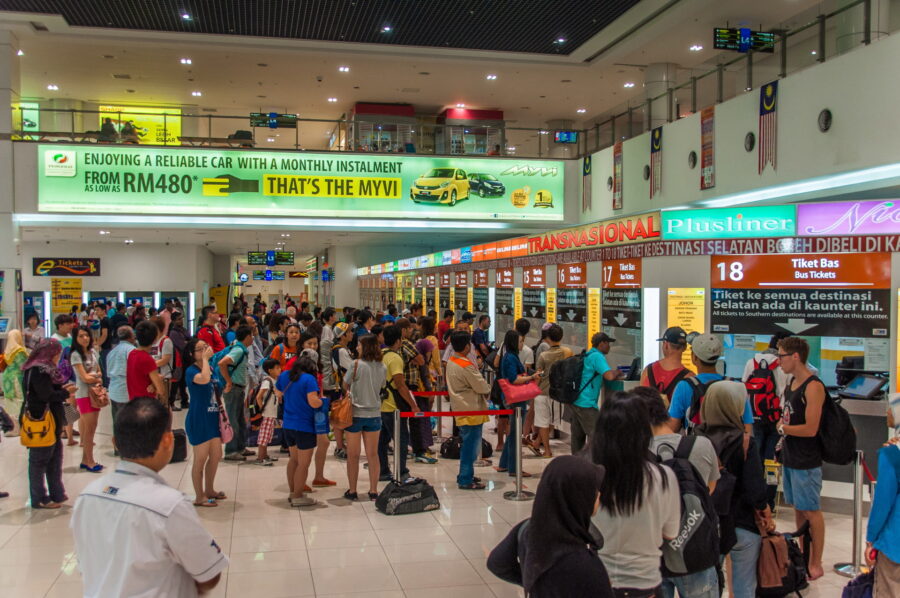
Terminals & organization
- Kuala Lumpur : the main terminal (TBS – Terminal Bersepadu Selatan) is modern, well organized, with ticket offices, luggage storage, shops and direct connection to the train/metro network.
- Penang Departures are from different terminals depending on the destination (Komtar, Sungai Nibong, etc.). It's less seamless than in Kuala Lumpur, but you can still find your way around.
- Autres villes : most have a dedicated bus station, sometimes out of the way (budget for a taxi/Grab to get to the centre).
Booking
- On site : directly at the bus station ticket office (possible at the last minute, outside of peak season).
- Online : practical for securing your journeys in advance or choosing the exact time.
- RedBus
- BusOnlineTicket
- Easybook (buses + trains + ferries)
Taxis, Grab & trishaws
Short journeys within the city or to/from train stations and airports are mostly made by Grave or taxi. You can still find trishaws in some cities with a more historical profile (Malacca, George Town).
Grab & taxis
- Grave : the local equivalent of Uber. It's the easiest way to get around town (KL, Penang, Johor Bahru, Kota Kinabalu…). Fare known in advance, payment by card or cash.
- Classic taxis They are present in all major cities, often at airports, in front of some malls and train stations. The fleet includes many Malaysian cars (Proton, Perodua).
- Counter & negotiation In Kuala Lumpur, insist on using the meter or use a prepaid taxi/Grab from official counters (especially at the airport). Elsewhere, you may be offered a fixed fare: it's up to you to decide if it's reasonable.
- General idea : airport ↔ KL city centre transfers via Grab or taxi around 70–100 RM depending on the time, type of vehicle and airport.

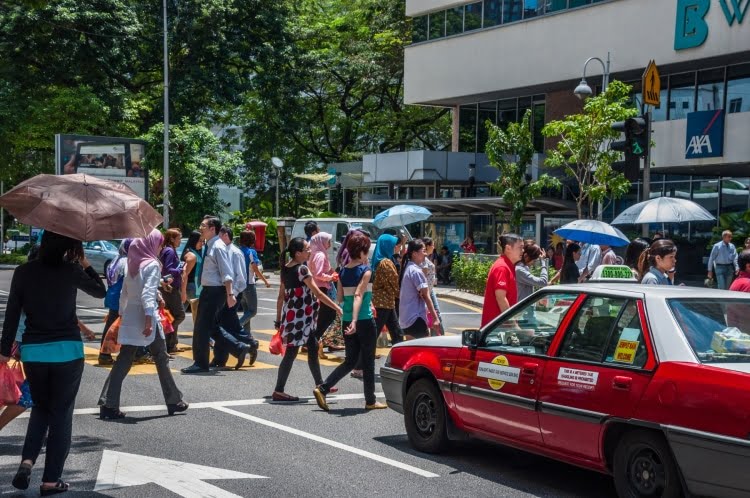
Trishaws (or beca)
- Present mainly in the historic old towns : Malacca, George Town (Penang).
- Usage rather tourism useful on a daily basis: a stroll through the old town centre, a “postcard” atmosphere.
- Pricing Tours are often advertised on time. Expect to pay around 40–50 RM for a short tour of about 1 hour in the historic center.
- It's a great addition for visiting a neighborhood without walking, or for the pleasure of the retro style.


Car Hire
Renting a car is a good option if you like being totally independent and are comfortable driving on the left.
- Where to rent? : airports (KLIA, Penang, Langkawi, Kuching, Kota Kinabalu…), city centers and sometimes local agencies in places like Ipoh or Kota Bharu.
- Pricing : expect to pay from €30–40 / day for a small local city car (Perodua, Proton), more for an SUV or a large sedan.
- Racing : we drive at leftRight-hand drive. Motorways are generally in good condition; caution is advised in rural areas, at night and during heavy rain.
- Tolls Most highways are toll roads (card or RFID system depending on the vehicle). When renting a car, always ask how the toll is managed (card provided, top-up required, etc.).

Documents and insurance
- Permits : national driver's license + international permit Highly recommended.
- Insurance : check the deductibles, theft and damage coverage, and exclusions (unpaved roads, off-road driving, etc.).
- Deposit : often blocked on bank card, amount varies depending on vehicle category.
If you do not wish to drive yourself, it is possible to use a service. private transfers or cars with drivers (more expensive, but convenient for certain targeted journeys).
Motorcycle/scooter and bicycle rentals
Renting a scooter is very common, especially on islands and in areas where public transport is limited.
- Where ? : Langkawi, Penang, Tioman (more occasional), some coastal towns and islands on the East coast.
- Pricing : generally around 35–50 RM / day for a basic automatic scooter, sometimes a little more on very touristy islands.
- Deposit : variable depending on the rental company (from a few dozen to a few hundred RM). Some agencies keep a copy of passport, others require a cash deposit.


Points requiring special attention
- Permits In theory, you need a international permit with the correct category (motorcycle/scooter) + national license. Without that, you risk being not covered through insurance in case of an accident.
- Helmet required and it's not just a question of a fine.
- road conditions : generally good, but watch out for wet roads, potholes and sand near the beaches.
- Controls & Assurance Even if the rental company doesn't ask for anything, they won't pay for hospital bills or damages in case of a major problem. Traveling with insurance remains essential.
If you don't feel comfortable on a scooter, don't force yourself: it's better to rely on local buses, Grab and private transfers.
Rail transport
Malaysia has a decent railway network on the peninsula, managed by Keretapi Tanah Melayu (KTM)Two main lines structure the country: the Western axis (towards Thailand and Singapore) and the Eastern axis, better known as the "Jungle Railway".

In addition to this, around Kuala Lumpur, there is a dense network of subways, monorails and commuter trains (Rapid KL, MRT, monorail, KTM Komuter, KLIA Ekspres) which allows easy travel in the capital and its region.
National Railway Network (KTM)
The KTM network mainly covers the peninsula.
- Western line (intercity) : from the Thai border (Padang Besar) to the south of the peninsula (Johor Bahru), passing through Butterworth (for Penang), Ipoh, Kuala Lumpur and Gemas. A good part of this line is today electrified and double trackwhich improves speed and frequency.
- Eastern Line ("Jungle Railway") : crosses the interior of the country, between Gemas and Tumpat near the East Coast. Slower but renowned for its jungle landscapes and its more "rootsy" side.
- Thailand Connection : in the North, trains allow you to reach the border (Padang Besar) and then continue towards Hat Yai and the rest of Thailand.
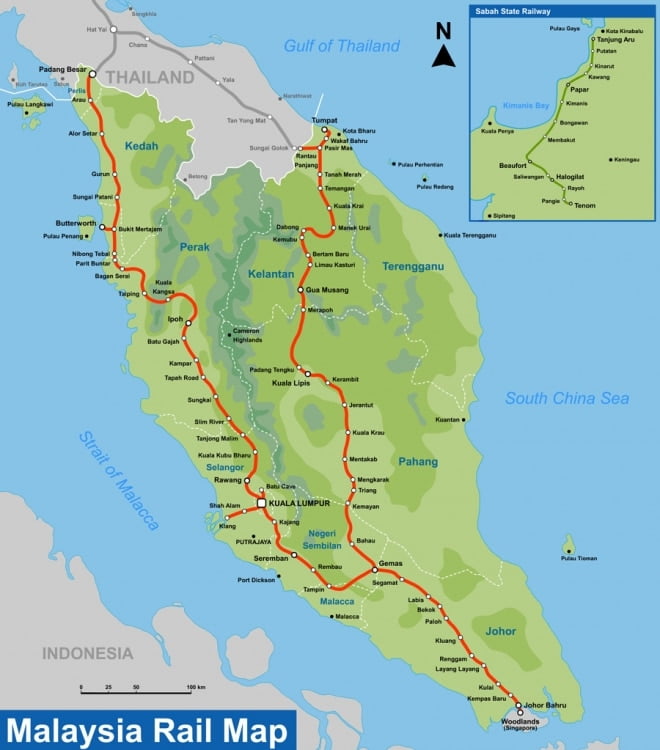
On Borneo, the network is almost non-existent: only the state of Sabah has a small line of 134 km connecting Tanjung Aru (Kota Kinabalu) to Tenom, a route especially popular with locals. It offers a vintage atmosphere and passes through landscapes of jungle and rice paddies.
- Basic comfort but an interesting journey for curious travelers
Malaysia has several types of trains, the comfort of which varies quite widely depending on the line and speed.
Train types & classes
- ETS (Electric Train Service) : modern, air-conditioned, comfortable high-speed trains.
Speed: ~140 km/h Ideal for : KL ⇄ Ipoh, KL ⇄ Penang, Penang ⇄ Padang Besar. - KTM Intercity : classic, slower trains, used on non-electrified lines (mainly the East Coast).
Recommended only for the Jungle Railway. - Available classes :
- Platinum (ETS) : fastest, limited stops.
- Gold (ETS) : good compromise (the most common).
- Silver (ETS) : the slowest of the three, but economical.
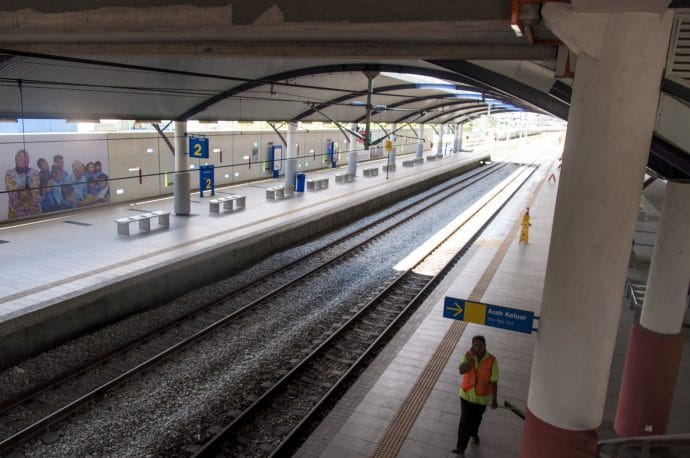
At Batu Cave KTM station.
Examples of routes, durations & prices
Here are some guidelines to help you understand typical distances, times, and budgets.
⭐ Peninsula – West Line (ETS Express)
- Kuala Lumpur → Ipoh : 2 h · ~25–35 RM
- Kuala Lumpur → Butterworth (Penang) : 4 h · ~50–70 RM
- Ipoh → Butterworth 1 hour 50 minutes · ~20–30 RM
- Kuala Lumpur → Padang Besar (Thailand border) 5 hour 15 minutes · ~70–100 RM
⭐ “Jungle Railway” – East Coast (Intercity diesel)
- Gemas → Tumpat (Kota Bharu) 9–12 pm · ~30–55 RM
- Kuala Lipis → Wakaf Bharu 6–7 pm · ~20–35 RM
- Gua Musang → Dabong : 2 h · ~5–10 RM
Footnotes Irregular schedules, sometimes very slow journeys but renowned for the scenery.
⭐ Komuter – Kuala Lumpur & regions
- KL Sentral → Batu Caves 30 min · 3 RM
- KL Sentral → Subang Jaya 25 min · 3–4 RM
⭐ Borneo – Sabah State Railway
- Kota Kinabalu (Tanjung Aru) → Beaufort ~2 h · 4–6 RM
- Beaufort → Tenom : 2 h · 2–4 RM
Book a train ticket in Malaysia
- Official site : ktmb.com.my (KTM Berhad).
- Platforms Some routes are also available on Easybook or other intermediaries.
The train is not always faster than the bus, but it is often More comfortable, with less jolting and the ability to move around in the carriage.
Metro & urban trains in Kuala Lumpur
The capital has a vast, modern and well-connected network, managed by Rapid KLFor a traveler, it's a simple and economical way to get around without relying on taxis. The lines cover almost all useful areas: Bukit Bintang, Chinatown, Brickfields, KLCC, Bangsar, etc.
The four main systems
- MRT (Mass Rapid Transit)
A modern, fast, and air-conditioned network. It serves as the backbone for crossing the city from north to south.
Very useful for: Bukit Bintang, Muzium Negara (KL Sentral), Jalan Kuching, Bandar Utama, Kajang. - LRT (Light Rapid Transit)
They cover the east and south of KL, convenient for connecting to Chinatown, Masjid Jamek, KLCC (via LRT Kelana Jaya).
Interest for the traveler: quick access to historical areas. - Monorail
Short but valuable line: connects hotel, mall and nightlife areas.
Useful for: Bukit Bintang ⇄ Imbi ⇄ Raja Chulan. - KTM Komuter
Commuter train linking KL Sentral to the outer areas (Batu Caves, Klang, Port Klang).
A must-see for: Us Batu caves easily and cheaply.
Everything is connected via the central station KL Central, a true multimodal hub.
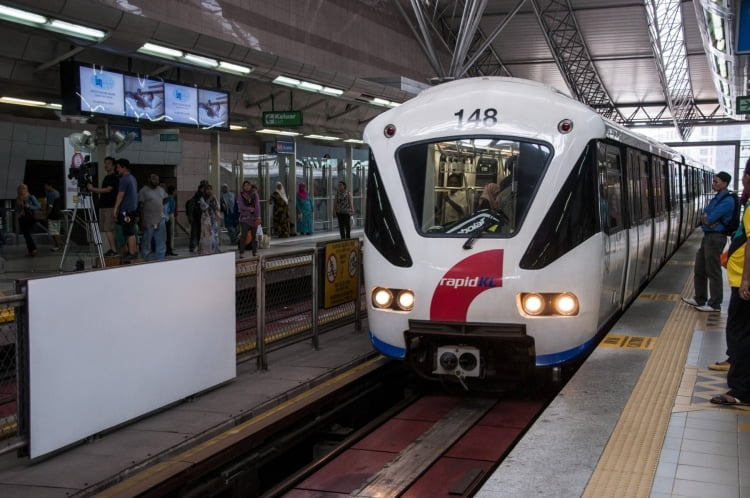
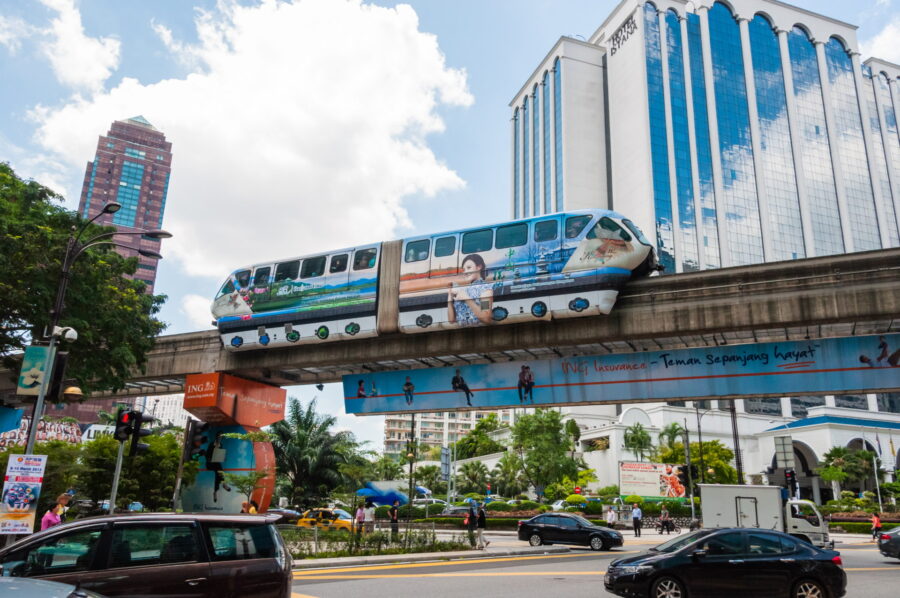
Examples of routes & prices (Kuala Lumpur)
- Bukit Bintang → KLCC (MRT + transfer): 10–12 min · ~2 RM
- KL Sentral → Batu Caves (KTM Komuter): ~30 min · 2.6 RM
- KLCC → Chinatown (Pasar Seni) ~10 min · 1.6 RM
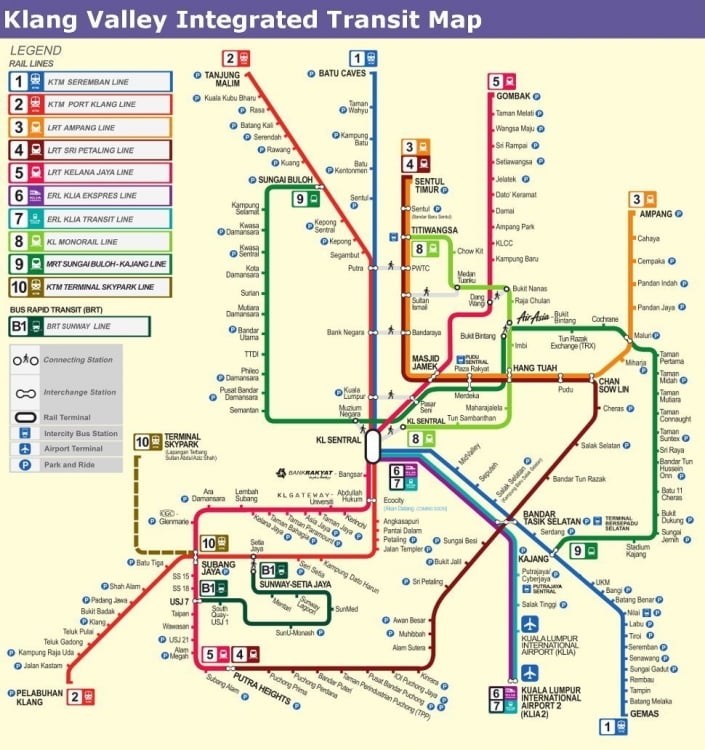
Recommended application : " KL Transit / Rapid KL » for timetables, journey times and connections.
River transport
With its islands on the peninsula (Langkawi, Penang, Perhentians, Redang, Tioman…) and those of Borneo (Gaya, Manukan, Sipadan, etc.), Malaysia relies heavily on ferries and fast boats to connect the islands to the coasts.

There are very short connections (simple crossing of 15–30 minutes) as well as longer journeys between main ports and more remote islands.
Ferries to the peninsula
On the peninsula, ferries are mainly used to reach the tourist islands.
- Langkawi : serves the coastal cities of Kuala Perlis et Kuala Kedah, as well as some connections to Thailand (Satun, Ko Lipe depending on the season and operator). The direct connection Langkawi ⇄ Penang Passenger ferry services were suspended after Covid and had still not returned to service at the time of the last check: check before relying on them.
- Penang Local ferries are available to cross to Butterworth (mainland). Longer connections to other destinations exist or have existed (e.g., Medan in Sumatra), but these often change: it's best to check the active routes at the time of travel.
- East Coast :
- Besut : main departure point for the Perhentian Islands.
- Merang : departure for Redang Island.
- Mersing : gateway to Tioman Island.
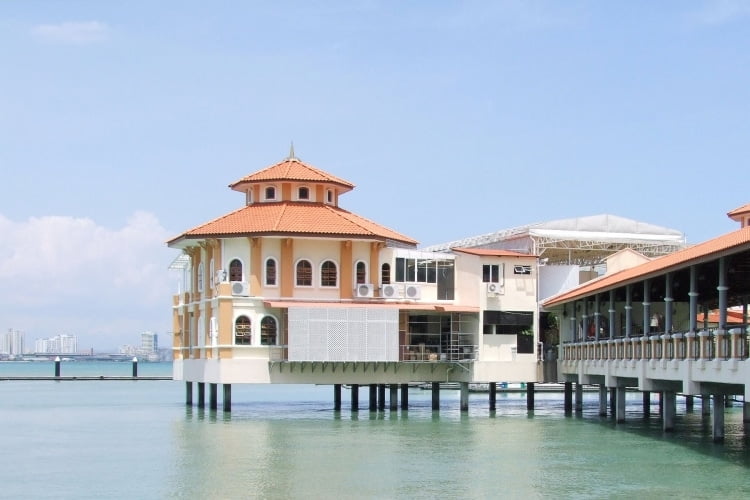
Booking & practical information
- Reservations can be made on-site via port counters or through platforms such as BusOnlineTicket ou Easybook.
- On certain islands classified as marine parks (Perhentians, Redang, Tioman), one must pay a conservation tax at the arrival.
- During the monsoon season (especially on the East Coast, from October to March), some services operate at reduced capacity or are even suspended. It is essential to check this before departure.
Ferries & boats in Borneo
In Borneo, boats are used as much for daily life of the locals than to tourist travel.
- Kuching Boats and ferries, with varying frequency, serve the areas along the coast and some river towns (like Sibu) or villages on the rivers.
- Labuan : federal island territory, accessible by ferry from several ports in Sabah and Sarawak, as well as from Brunei.
- Kota Kinabalu (Jesselton Point) : departure point for the islands of Tunku Abdul Rahman Park (Gaya, Manukan, Sapi…). Quick crossings, several times a day.
- Sandakan & Tawau : ports oriented towards different connections, including with the Philippines or Indonesia (schedules and security to be checked depending on context).
- Semporna : main base for reaching the islands of the region (Mabul, Kapalai, Bohey Dulang, Sipadan, etc.). There are a multitude of diving operators and shuttle boats.
As always in island areas, connections can be impacted by the weather forecasts or safety considerations: do not schedule an international flight too close behind a last ferry.
Air transport
With many international airports and a dense network of domestic flights, the airplane is a fast way to connect different regions of Malaysia, especially between the peninsula and Borneo, or to avoid long hours on buses.
Main airports
- Kuala Lumpur International Airport (KLIA & KLIA2) : main international hub of the country, base of Malaysia Airlines and AirAsia (KLIA2).
- Subang (Sultan Abdul Aziz Shah) : closer to the centre of KL, used by some regional companies (notably Firefly).
- Langkawi : international airport, useful for connecting to Thailand or other regional destinations.
- Penang : serves the island and acts as a convenient entry point to the north of the peninsula.
- Johor Bahru (Senai) : near Singapore, a low-cost hub for some domestic and regional routes.
- Kota Kinabalu & Kuching : main airports of Borneo on the Malaysian side.
- Smaller airports complete the map (Sandakan, Tawau, Miri, Sibu, Labuan, etc.), especially useful for Borneo.


Airlines companies
- Malaysia Airlines : national airline, serves major Malaysian cities and numerous international destinations. Checked baggage is often included on regular flights.
- Firefly : regional subsidiary of Malaysia Airlines, operates mainly from Subang to cities in the peninsula and region.
- MASwings : specializing in internal connections in Borneo (Sabah & Sarawak) and certain regional routes.
- Batik Air Malaysia (ex Malindo Air): a Lion group company, serving several domestic and regional routes.
- AirAsia (and AirAsia X for long-haul flights): a low-cost carrier with a strong presence in Southeast Asia, very convenient for domestic flights and regional connections (Bangkok, Hanoi, Singapore, etc.). Checked baggage is an extra charge on most tickets.

Fare & route ideas
- Domestic flights : often very affordable if booked in advance (e.g. KL ⇄ Kuching, KL ⇄ Kota Kinabalu, Penang ⇄ Langkawi, etc.).
- Peninsula ⇄ Borneo : prefer the plane if you have limited time; the time saved compared to a journey combining bus + boat + possible detours is considerable.
- baggage Check carefully what is included (especially with low-cost airlines). A cheap ticket can quickly become very expensive as soon as you add checked baggage.
- Connections : avoid overly tight connections between an international flight and a domestic flight, especially if you are changing airports (KLIA ⇄ Subang for example).


Practical advice
- Anticipate For peak periods (local festivals, Malaysian school holidays, Hari Raya, Chinese New Year): prices rise quickly and some flights fill up very early.
- Compare Schedules and airports: for example, some flights depart from Subang rather than KLIA, which may be more convenient if you are staying in central Kuala Lumpur.
- Check the baggage policies : a €20 flight without baggage can end up being more expensive than a €40 flight with 20 kg included.
- Read the fine print for non-refundable/non-changeable tickets, especially on low-cost airlines.
Malaysia is a country where you can find easily find accommodation that suits your budgetWhether you're travelling in economy, comfort or luxury, the selection is vast and well distributed throughout the country. Competition is becoming fierce, as the country has doubled its number of tourists in just two years, now exceeding 20 million visitors annually!
The prices remain very reasonable For Southeast Asia: there are many homestays and small hotels around 25 € per night, sometimes less so outside of peak season. Large cities like Kuala Lumpur or George Town also have a wide choice of upscale hotels, often at more attractive prices than in Thailand or Singapore.
Whether you prefer high-end hotels or, on the contrary, very economical dormitories, you will also find everything you need: modern hostels, boutique hotels, family guesthouses, large complexes with swimming pools or even seaside resorts on the islands.
As I regularly return to Malaysia, I won't list all the hotels I've tested here, but I will mention a few in some destinations I visit regularly and then suggest... two favorites.


For example:
In Kuala LumpurSince I'll be sharing my favorite place later, I'll mention here that I stayed at the airport! Yes, because the airport is quite far from the city center (over 40 km), so staying there, depending on your flight schedule, can be a good option. To do this, I had tried the CapsuleTransit Airside KLIA T2 Airport Hotel
In Langkawi, I had stayed at The Cottage LangkawiA basic hotel with rooms, a little off the main street. Rustic but clean, so not much to complain about for the price.
To IpohI needed a little more comfort because I was with Jitima, and she was choosing the Travelland HotelIt's a bit outside the city centre, but since we were renting a car, it wasn't a problem, and it's available for less than €30 depending on the season (beware of misleading photos that suggest there's a swimming pool; it's actually a water park). Sunway Lost World Theme Park(which is nearby).
I'm keeping the two best addresses below, in Penang, then the last one tested in Kuala Lumpur.
Practical advice
- Air-conditioning : useful in the plains (Vientiane, Pakse), less essential in the mountains.
- Hot water : not always guaranteed in the simplest guesthouses.
- Wi-Fi : variable, often correct in towns, random in remote areas.
- Mosquito : common in bungalows; sometimes useful depending on the season.
- Booking : recommended for Luang Prabang (high season) and Lao New Year (mid-April).
The overall standard remains simple, but there is no shortage of charming places to stay — especially in the north and around the Mekong.
B Street Hotel
Note: 8,7 / 10
Budget: from €18
There will certainly be cheaper options in Penang, but among the many hotels tested on the island, the B Street is clearly at the top of the ranking with a very good value for money.
Its only drawback was the slightly cramped rooms. But I appreciated its location, not too far from the Komtar Tower (which is clearly visible from their rooftop terrace) and still quite close to old George Town while being on a quiet street.
Santa Grand Signature
Note: 8,7 / 10
Budget : from 37 €
For a hotel under €40, I can't think of anything better! Hotel with comfortable room, swimming pool, superb view of the city, opposite the Kuala Lumpur Eco Park.
I also enjoyed its bar and restaurant (next to the pool), which I tried every evening, which brings us to its only drawback. It's a bit isolated; there are two metro stations within walking distance on either side, but not really any restaurants or local life nearby.
To book a hotel in Malaysia, here is the search tool:
Local currency : the official currency is the Malaysian ringgit (MYR)You will mainly be handling ticketsThe coins circulate but are mainly used for small everyday purchases.
- Parts : 5, 10, 20 and 50 sen.
- Tickets : 1, 5, 10, 20, 50 and 100 MYR.
Rates & context : the ringgit has been experiencing a for several years gradual depreciation against the euro. Rates vary slightly depending on where you exchange currency. bank, a money changers or via bank withdrawal.
- Useful reference points (order of magnitude): 10 MYR ≈ €2 ; 100 MYR ≈ €20 depending on the current exchange rate.
For a quick estimateSimply divide by 5. Ex. 45 MYR → 45 / 5 ≈ €9
Daily : la Bank card is widely accepted in cities, shopping centers, restaurants and accommodations. However, expect to pay a little extra cash for street stalls, local transport, some small restaurants and more rural areas.
- On distributors are common, but some banks apply fixed costs by withdrawal.
- Avoid withdrawing very small amounts: it's better to make a larger withdrawal to limit fees.
USD / EUR: foreign currencies are not not used to pay on a daily basis, but are easily changeable in the money changers (especially in Kuala Lumpur, Penang and Kota Kinabalu). Always compare rates: exchange bureaus in shopping malls usually have the best rates.
Price benchmarks
Accommodation
- Simple guesthouse: €10–18 at night (Kuala Lumpur, Penang, Malacca).
- Comfortable guesthouse / small private room: €18–30.
- Chalet / bungalow in the islands (Perhentian, Tioman, Langkawi): €25–45.
- Charming hotel / boutique hotel: €40–80 depending on the city and the season.
- Luxury hotel: €90–180+, sometimes more so in the island resorts.
Catering
- Hawker center / food court / local restaurant: €2–4 the dish.
- Local breakfast (roti canai, nasi lemak, coffee): €1,50–3.
- Coffee / tea / soft drink: €0,60–1,50.
- A “standard” restaurant frequented by locals and travelers: €4–7 the meal.
- Tourist restaurant / international cuisine: €8–15 (or even more in KLCC or Georgetown).
Transport
- Grab race in the city: €1,50–4 depending on the distance (significantly more reliable than taxis).
- City bus (Kuala Lumpur RapidKL, Penang CAT/rapidPenang): €0,30–0,70.
- Intercity bus (2–4 h): €4–8 depending on destination and comfort.
- Long distance bus (6–8 hours, e.g. KL → Penang / Kuala Besut): €8–15.
- Ferry to the islands (Perhentian, Tioman, Langkawi): generally €15–25 round trip.
- Domestic flight (KL ⇄ Penang / Langkawi / Kota Bharu / Kuching / Kota Kinabalu): €20–60 One-way trip depending on anticipation and period.
Visits
- Entrance to a temple or local site: often free to 1–3 €.
- Batu Caves (KL): free (excluding paid attractions).
- National museums / galleries: €1–4.
- SkyBridge Petronas (KLCC): approximately €18–20.
- Mount Kinabalu Park (Sabah): €5–10 the entrance (without guide or climb).
- Snorkeling tour in Perhentian / Tioman: €10–25 depending on duration.
For data updated (consumer prices, meals, transport), consult Numbeo for malaysia (or by city if necessary: Kuala Lumpur, Penang, Johor Bahru, etc.).
Small budget
Average budget
Comfortable
Malaysia remains a fairly comfortable country to travel in, with a good level of healthcare and a generally peaceful atmosphere. This doesn't mean you shouldn't take some basic precautions, both for your health and safety, especially if you're traveling in Asia for several weeks or months.
In terms of safety, Malaysia is not a particularly anxiety-inducing country, but like everywhere else, there are a few things to know to avoid trouble, especially in large cities and certain border areas.
Feedback from experience
Having tested a Malaysian hospital (Penang) after a bedbug infestation: not up to the standard of the best Thai hospitals, but efficient and affordableThe reception can be a little disorganized, but once you're taken care of, it goes quickly.
Travel insurance — is it really necessary?
As everywhere in Asia, travel insurance can truly make a difference if something goes wrong. Whether you're going away for two weeks or several months, bank card coverage remains limited:
- medical expenses are capped at around €10,000 (often insufficient in case of hospitalization);
- no full civil liability;
- No upfront payment required in private hospitals.
Dedicated travel insurance generally covers up to €200 minimum for care, which avoids getting stuck hesitating to get treatment "so as not to blow the budget".
I recommend you Heymondo Travel Insurance (5% discount via my link).
Transparency: if you subscribe via this link, I will receive a small commission — at no extra cost to you.
Which vaccines, what do I need to know?
No vaccinations are required to enter Malaysia, but the "standard Southeast Asia" recommendations apply:
Basic vaccinations (up to date)
- DTP (adults)
- ROR (children)
Recommended vaccines depending on the trip
- Hepatitis A
- Hepatitis B
- Typhoid
- Rage (rural stays / contact with animals)
- Japanese encephalitis (extended stays in rural areas, rice paddies, jungle)
- TB (special cases)
Japanese encephalitis remains rare but does occur, especially beginning of the rainy seasonSince it is transmitted by mosquitoes, mosquito control measures remain by far the most important.
Mosquitoes & Diseases
Mosquitoes are clearly not a traveler's friend in Malaysia.
Malaria
- Very marginal in Peninsular Malaysia;
- present in certain areas of Borneo (rural Sabah/Sarawak);
- useless in Kuala Lumpur, Penang, Malacca, Langkawi, Perhentian, Tioman, Cameron Highlands…
A typical treatment Malarone is not usually Not recommendedexcept for prolonged expeditions in isolated jungles.
Dengue
It's the main riskThere is no no treatmentThere is no miracle protocol: prevention is everything.
Other possible illnesses
- Chikungunya
- Zika (Increased caution for pregnant women)
Mosquito protection
- Effective repellent (tropical areas).
- Outfits clear, long sleeves in the evening or in the jungle.
- Impregnated clothing possible.
- In the jungle: opt for lightweight trousers + socks.
If you have a fever Consult a doctor promptly during your trip. A specialized dengue hospital is located in [location missing]. Buloh River (Kuala Lumpur).
Address: Hospital Sungai Buloh, Jalan Hospital, 47000 Sungai Buloh, Selangor
Hygiene in Malaysia
Malaysia has a good sanitary standardsHowever, a few simple rules can prevent unpleasant surprises:
- Wash your hands before meals (use hand sanitizer if needed).
- Tap water not potable → choose bottled water with a sealed cap.
- Meats / fish well cooked.
- Avoid the horseshoe crab (horseshoe crab): cases of serious poisoning have been reported.
- Avoid swimming in stagnant water.
- Do not walk barefoot in wet areas / dirty sand.
- Do not pet stray animals.
- Postage due helmet and belt (valid everywhere).
Useful kit
- antiseptic;
- treatment of digestive disorders;
- mosquito repellent;
- sunscreen;
- burn cream;
- bandages / compresses.
Safety in Malaysia
Malaysia remains, overall safe, but in large cities like Kuala Lumpur, a few simple precautions are still useful.

Scams, fraud and crime
- Bag snatching possible by scooter.
- Opportunistic thefts in tourist areas.
- Some cases of skimming (copying credit cards) in some hotels or restaurants.
- Case of drugged drinks reported in some bars → always keep an eye on your drink.
The feeling on the ground remains consistent with all of this: during the day, the atmosphere is rather serene; in the evening, caution depends mainly on the neighborhoods and the atmosphere.
Risk areas
Sabah – north and east coasts
Specific risk related to:
- armed groups (affiliated with Daesh);
- abductions;
- maritime piracy.
The region is under ESSCOM command (curfew, military presence). Navigation in the area (Sulu Sea, Celebes Sea) is therefore strongly discouraged.
Malaysia-Thailand border
The mountainous area on the Kedah/Perlis/Kelantan side may contain:
- various types of trafficking;
- tensions (same dynamics as the provinces of Southern Thailand).
Cities like kangaroo ou Kota Bahru do not pose any particular problem.
Emergency numbers & useful contacts
Emergency numbers
- Police / Ambulance : 999 (landline telephone)
- Mobile Emergency : 112
- Tourist Police +60 3 2149 6590
Hospitals in Kuala Lumpur
- General Hospital +60 3 2692 1044 (public hospital)
- Gleneagles Hospital (Jalan Ampang):
- Emergency services: +60 3 4141 3017 / +60 3 4141 2718
- Ambulance: +60 3 4141 3131
- Malaysian Red Crescent +60 3 4257 8122
Hospitals outside of Kuala Lumpur
- Sarawak General Hospital (Kuching / Sarawak): 22 57 555
- Gleneagles Hospital (Penang): 22 76 111
French Embassy in Malaysia
Level 31, Integra Tower, 348 Jalan Tun Razak, 50450 Kuala Lumpur
Winter +60 3 2053 5500
Emergency services +60 12 201 3540
Embassy website: https://my.ambafrance.org/
Travel advice from the Ministry of Foreign Affairs (France Diplomacy) : Malaysia fact sheet










